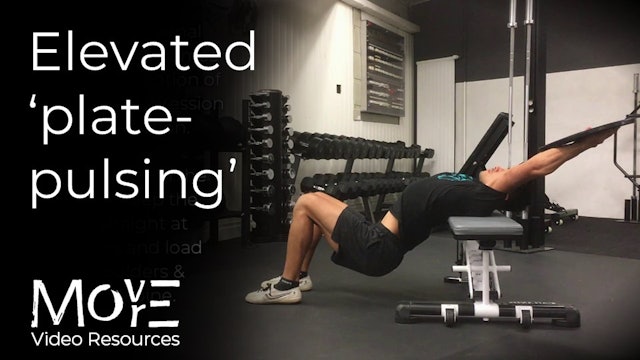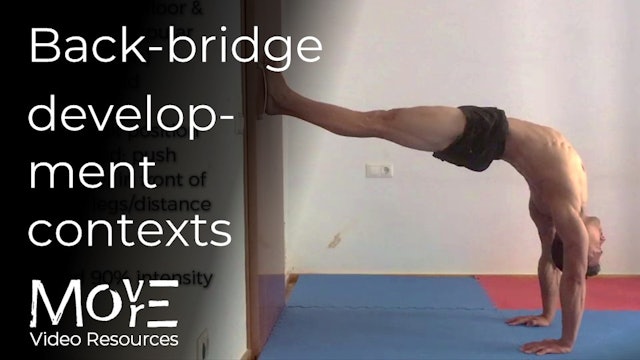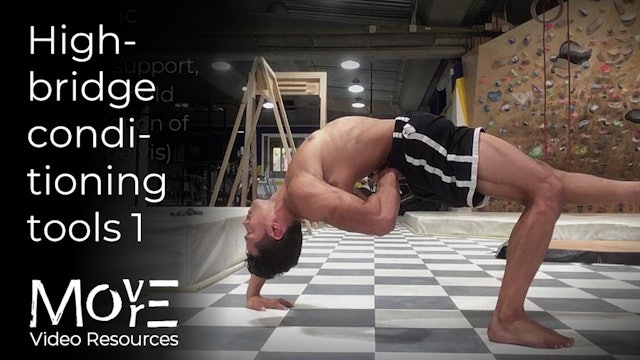'Bridging' & global-extension
These contexts are collectively concerned with mobility-development in the general range of ‘global-extension’, effectively referring to the potential of the full-body (i.e. ‘global’) structure to extend backward and sustain this form with intrinsic STRENGTH. Whilst this is simultaneously the world of ‘back-bending (the most general context of reaching-backward overhead) and ‘bridging’ (forming a globally-extend arc with the hands/feet FIXED in space), ranges of HIP-EXTENSION and overhead SHOULDER-FLEXION are also requested, as limitations here ultimately transfer to a greater, and less desirable, request for extension from the SPINE. The keyword of emphasis in the term ‘global-extension’ is the first: GLOBAL. This means that, in optimal execution, extension should be spread as EVENLY as possible across the FULL structure of the body so that more mobile parts of the spine (most commonly the lumbar-region) do not continually endure the brunt of extension-force.
LEARN MORE (subscriber-only):
https://drive.google.com/file/d/1rpAHPdtjB7nfn98KLJVaXrpNcpUwiSPX/view?usp=drive_link
-
Elevated plate pulsing
'OPEN-SHOULDER' POSITION vs. 'SHOULDER-MOBILITY':
A loaded open-chain tool for developing mobility in the thoracic spine & 'open-shoulder' position. One thing which should be understood from the outset is that 'open-shoulder' refers a FORM (or, rather, and ANGLE under the armpit between your tor...
-
Anterior-shoulder chest & RC stretches
THE WHAT:
Simple stretching variations for regular use toward mitigating & reversing kyphotic posture. Whether through lifestyle or practice habits, 'kyphosis' is characterised by excessive hypertonicity in the anterior musculature of the upper-body, translating to general "tightness" in both 'pr... -
Overhead (OH) shoulder ROM and stability routine
THE WHAT:
A basic overhead (OH) shoulder-stabilisation and range-of-motion (ROM) sequence to help keep your shoulders in their sockets. For those who are extremely hyper-/flexible, working with rotations WITHIN the end-ranges will help to build STRENGTH there (ie. 'stability' in this context') to... -
Lumbar-extension stretching
THE WHAT:
Simple contexts for exploring & developing the ranges of lumbar extension in a low-intensity manner, simply by locating and “releasing” any excess, “superficial” tension being held in both the abdominal and lower-back musculature. BE MINDFUL of your sensations and AVOID stretching too “... -
Quadriceps & hip-flexor stretches
THE WHAT:
Fundamental static stretches affecting the "hip-flexors" & quadriceps complex. Whist incomplete in themselves for developing sustainable and USABLE ranges in the long-term, their convenience allows them to be more easily cultivated into an habitual daily practice, one of the most powerf... -
'Scorpion Tail' (mobility & patterning)
THE WHAT:
The 'Prone tail-reach' & 'Scorpion tail' are isolated movements which will assist in the development of hip-flexors & trunk rotational mobility and range. It also develops the patterning for what is ultimately a TRANSITIONAL tool which can be incorporated into locomotion and low-floor w... -
The 'Handstand-7' (HS-7)
THE WHAT & HOW:
The 'Handstand-7' is a fundamental structural awareness drill which facilitates learning the sensation of a "stacked" structure, i.e. having the hips stacked over the shoulders stacked over the hands in an alignment which results in supporting your centre of mass (around the pelvi... -
Wall-facing tuck-handstand
THE WHAT:
The wall-facing tuck-handstand can play a double role in practice. Firstly, in the context of HANDSTAND practice, it can be used to explore to pattern the structure & form of the tuck HS, build proprioception of the legs & accustom to the stresses particular to the form.Secondly, wall...
-
Back-bridging development
THE WHAT:
A range of back-bridging development drills for improving range and mobility in global spinal-extension (also strongly affecting overhead shoulder-flexion range), also incorporating expression of TRANSVERSE ROTATION in the ‘Wall bridge-rotations’ and ‘Low-bridge wall-rotation’ forms. As... -
High-bridge rotation (HBR)
THE WHAT:
A progressive mobility form developing global extension and (other than 'Posting') a rotational pattern which facilitates seamless entrance & exit from a back-bridge position.As with its shorter brother, the 'Low-bridge rotation', this intrinsic rotational quality opens up immediate c...
-
Low-bridge 'slide' & Low-bridge Rotations (LBR)
THE WHAT:
The 'low bridge' is a context which has the dual benefit of developing mobility in the anterior chain, as well opening up movement possibilities. As the lumbar spine is also in a much more neutral position than in a high-bridge, for example, it can still be practiced even by those with ... -
High-bridge conditioning tools 1 (4, 3, and 2-point supports)
THE WHAT & HOW:
Contexts for expressing & developing the strength, stability, structural awareness, and adaptability of the fundamental high-bridge form. As with all regressive and progressive ‘global-extension’ forms, always work with the intention of spreading as much of this extension as EVENL... -
High-bridge conditioning tools 2 (1-arm & 'HBPU' variations)
THE WHAT & HOW:
Contexts for expressing & developing the strength, stability, structural awareness, and adaptability of the fundamental high-bridge form. As with all regressive and progressive ‘global-extension’ forms, always work with the intention of spreading as much of this extension as EVENL... -
Bridge walking (forward & back)
THE WHAT:
Whilst a simple conditioning context expressing capacities in the fundamental ‘High-bridge’ form, ‘Bridge-walking’ also challenges the practitioner’s structural-awareness & coordination. This is namely with regards to the SIMULTANEOUS stepping of the OPPOSITE hand/foot, making it a CONT... -
Standing-to-bridge contexts
THE WHAT & HOW:
Contexts for exploring a controlled transition from standing, into bridge. Whilst in its isolated practice (standing/Sissy-squat to bridge & returning) significant control in back-bending range is requested & developed, in the integrated variations it ultimately serves as a bipeda... -
Floor 'Butcher's block'
THE WHAT & HOW:
A fundamental & easily accessible context for development of the 'open-shoulder' position (facilitating overhead arm-flexion range) in a loaded, isometric context. As part of its form & execution, the 'hollow-body' position is also drilled & conditioned in a prone position, resist... -
The 'Hollow-Body'
THE WHAT:
A foundational bodyweight strength exercise which develops transferable understanding and conditioning of the fundamental "hollow-body" position. This characteristically globally-concaved structure is fundamental in that it produces maximal TENSION in the body, radiating from the inside...



















